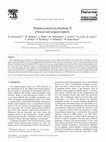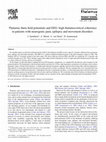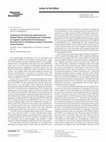Papers by Daniel Jeanmonod
Bildverarbeitung für die Medizin 1998, 1998
In the context of MRI-guided stereotaxy a new stereotaxic atlas of the human thalamus was develop... more In the context of MRI-guided stereotaxy a new stereotaxic atlas of the human thalamus was developed in order to improve anatomical definition and precision in the prediction of the exact location of thalamic targets. It is based on multiarchitectonic parcellation (Nissl, myelin, calcium-binding proteins). Sagittal atlas data were digitized and registered together with 3D MRI data sets. In a coarse to fine strategy the atlas-to-patient transformation matrix is refined. Thus the atlas is tailored to the individual anatomy of the patient. The effects of the rigid transformation are directly monitored on the computer screen using visible anatomical landmarks as control.

Thalamus & Related Systems
The companion paper (Llinás et al., 2001) presents evidence, at both cellular and network levels,... more The companion paper (Llinás et al., 2001) presents evidence, at both cellular and network levels, for the role of resonant oscillatory thalamocortical properties in normal and pathological brain function. Here we present confirmatory single cell electrophysiology from the thalami of thalamocortical dysrhythmia (TCD) patients and review our surgical approach towards the relief of this chronic disabling condition, in its many forms. The goal of surgery is a rebalancing of the abnormal thalamocortical oscillation responsible for TCD. Our approach uses small strategically placed pre-thalamic and medial thalamic lesions that serve to make subcritical the low frequency thalamocortical reentry network attractor via desinhibition and desamplification. The lesions address classical and new stereotactic targets that provide therapeutic efficiency coupled with the sparing of the specific thalamocortical loops.
Thalamus & Related Systems
Thalamic and cortical neurons are richly and reciprocally interconnected and support recurrent fu... more Thalamic and cortical neurons are richly and reciprocally interconnected and support recurrent functional loops in the intact brain, but the role of this circuitry is still poorly understood. Here, we present evidence—from cellular and from functional neuroimaging in control and clinical domains—that thalamocortical resonance is not only a prerequisite for normal cognition, but that its perturbation, in a dynamic sense (e.g. a dysrhythmia) can underlie a variety of neurological and psychiatric disorders.

Thalamus and Related Systems, 2003
We simultaneously recorded local field potentials (LFP) in the thalamus and EEG on the scalp of 1... more We simultaneously recorded local field potentials (LFP) in the thalamus and EEG on the scalp of 17 patients suffering from neurogenic pain, epilepsy and movement disorders. The EEG of 11 patients displayed enhanced power in the theta frequency range (4-8 Hz). The thalamic LFP of 14 patients peaked in the theta range. The theta coherence between EEG and LFP was significant for 12 patients and reached strengths up to 70%. These findings suggest that enhanced theta rhythmicity occurs in tight functional thalamocortical loops and is a major element in all three diseases investigated. To investigate second-order phase-coupling between LFP frequency components, we computed the bicoherence and averaged over the group of patients. We found peaks in the theta band and the beta band (14-30 Hz), indicating phase correlations of oscillatory events in these frequency ranges with their first harmonic. A further peak indicates that phase coupling occurred also between theta and beta frequencies. This indicates a strong functional interaction between the generators of these oscillations. We also computed the cross-correlation between LFP spectral power at different frequencies. Although this measure is independent of phase, we found good agreement with the bicoherence patterns, pointing again to strong interaction between theta and beta rhythmicity. The overproduction of theta rhythms, the thalamocortical coherence and the correlation of theta with beta rhythms are key elements for the understanding of thalamocortical dysrhythmia (TCD).

Schweizerische Rundschau fur Medizin Praxis = Revue suisse de medecine Praxis
69 patients suffering from chronic therapy-resistant neurogenic pain of peripheral and/or central... more 69 patients suffering from chronic therapy-resistant neurogenic pain of peripheral and/or central origin underwent a stereotactic medial thalamotomy. Medial thalamic unit recordings were performed peroperatively, allowing the physiological confirmation of the electrode location and the recognition of a specific physiopathology. Thanks to these recordings, a concept was developed, based on the presence of an imbalance between medial (nucleus centralis lateralis mainly) and lateral (nucleus ventroposterior) thalamic nuclei, resulting in an over-inhibition of both by the reticular thalamic nucleus, and then in a paradoxical activation of pain-related cortical areas. The medial thalamotomy, re-actualized by new technical, anatomical and physiological data, offers a 50-100% relief to 67% of all patients with peripheral as well as central neurogenic pain, on all body localizations, without producing neurological deficits and without risk for the development of iatrogenic pain.
Thalamus & Related Systems, 2001
... M. Magnin et al./Thalamus & Related Systems I (2001) 81-89 ... pictures with their fiduci... more ... M. Magnin et al./Thalamus & Related Systems I (2001) 81-89 ... pictures with their fiducial points were produced to determine the three coordinates of the target re-ferred to the intercommissural line, using a MR adaptation of a CT technique (Jeanmonod and Thomas, 1989) and ...
NeuroImage, 2009
220 F-PM Enhanced low and high frequency resting EEG activity in patients with chronic severe obs... more 220 F-PM Enhanced low and high frequency resting EEG activity in patients with chronic severe obsessivecompulsive and psychotic disorders

NeuroImage, 2000
In 1997, Morel, Magnin, and Jeanmonod presented a microscopic stereotactic atlas of the human tha... more In 1997, Morel, Magnin, and Jeanmonod presented a microscopic stereotactic atlas of the human thalamus. Parcellations of thalamic nuclei did not only use cyto- and myeloarchitectonic criteria, but were additionally corroborated by staining for calcium-binding proteins, which bears functional significance. The atlas complies with the Anglosaxon nomenclature elaborated by Jones and the data were sampled in three orthogonal planes in the AC-PC reference space. We report on the generation of three-dimensional digital models of the thalamus based on the three sets of sections (sagittal, horizontal, and frontal). Spatial differences between the three anatomical specimens were evaluated using the centers of gravity of 13 selected nuclei as landmarks. Subsequent linear regression analysis yielded equations, which were used to normalize the frontal and horizontal digital models to the sagittal one. The outcome is an internally consistent Canonical Model of Morel's atlas, which minimizes ...
Thalamus and Related Systems, 2001
Thalamic and cortical neurons are richly and reciprocally interconnected and support recurrent fu... more Thalamic and cortical neurons are richly and reciprocally interconnected and support recurrent functional loops in the intact brain, but the role of this circuitry is still poorly understood. Here, we present evidence-from cellular and from functional neuroimaging in control and clinical domains-that thalamocortical resonance is not only a prerequisite for normal cognition, but that its perturbation, in a dynamic sense (e.g. a dysrhythmia) can underlie a variety of neurological and psychiatric disorders.

Thalamus and Related Systems, 2005
ABSTRACT Neurophysiological studies at the cellular level (microelectrode unit activity recording... more ABSTRACT Neurophysiological studies at the cellular level (microelectrode unit activity recordings and local field potentials) as well as electro- and magnetoencephalographic recordings provide converging evidence for a thalamocortical dysregulation at the source of chronic neurogenic pain of both peripheral and central origin. These indicate an increase of low frequency thalamocortical rhythmicity originating in disfacilitation of thalamic relay neurons, followed by cortical activation due to asymmetries of corticocortical inhibition. This process, called thalamocortical dysrhythmia, might become self-sustained and, thus, chronic due to recurrent thalamoreticulothalamic and corticoreticulothalamic feedback inhibition. Our surgical approach is centered on re-establishment of normal thalamocortical oscillatory activity using small, strategically placed medial thalamic and prethalamic lesions. These reduce the increased low frequency thalamocortical recurrent network activity via low frequency desamplification and thalamic disinhibition, providing long term therapeutic efficiency coupled with sparing of the specific thalamocortical loops.

Stereotactic and functional neurosurgery, Jan 19, 2015
Background: Subthalamic stereotactic interventions have recently caught renewed interest as a tre... more Background: Subthalamic stereotactic interventions have recently caught renewed interest as a treatment for essential tremor (ET). However, it is not clear whether these interventions are associated with neurocognitive, mood or personality changes. Objective: To investigate neurocognition, neuropsychiatric functions and personality variables in patients with ET and to explore the neurocognitive and neuropsychiatric effects of cerebellothalamic tractotomy (CTT), a form of subthalamotomy. Methods: In our study, we investigated cognitive functions, frontal functions, mood and personality variables in 5 patients with intractable ET. Patients were tested before and 3 months after surgery using neuropsychological tests, clinical scales for depression, anxiety, anger regulation and a personality test. Results: Before surgery, ET patients showed normal neurocognitive function, a slightly elevated frontal lobe score in the dimensions mental control and memory, without being indicative of a f...

Potential applications of Transcranial Magnetic Resonance guided Focused Ultrasound (TcMRgFUS) in... more Potential applications of Transcranial Magnetic Resonance guided Focused Ultrasound (TcMRgFUS) include treatment of functional brain disorders, such as Parkinson's disease, dystonia and tremor, neurogenic pain and tinnitus, neuropsychiatric disorders and epilepsy. In this study we demonstrate the feasibility of non-invasive TcMRgFUS ablation of clinically well established targets in the human thalamus that are currently accessed stereotactically by interventional strategies based on the concept of the thalamocortical dysrhythmia (TCD). Thermal hotspots suitable for clinical intervention were created successfully in anatomical preparations of human ex-vivo heads under pseudo clinical conditions. The hotspots could be positioned at the target locations as needed and local energy deposition was sufficient to create tissue ablation. Numerical simulations based on these experimental data predict that the acoustic energy needed to create ablative lesions in-vivo will be within limits that can safely applied.
Based on Golomb's arithmetic formulas, Dirichlet series for two classes of twin primes are constr... more Based on Golomb's arithmetic formulas, Dirichlet series for two classes of twin primes are constructed and related to the roots of the Riemann zeta function in the critical strip.
Thalamus & Related Systems, 2003
Clearly, more clinical experience must be amassed to define in detail the possibilities of this s... more Clearly, more clinical experience must be amassed to define in detail the possibilities of this surgical approach in disabling neuropsychiatric disorders. We propose, however, that the evidence for benign and efficient surgical intervention against the neuropsychiatric TCD syndrome is already compelling. The potential appearance of strong postoperative reactive manifestations requires a close association between surgery and psychotherapy, with the latter providing support for the integration of the new situation as well as the resolution of old unresolved issues.
NeuroReport, 1993
ABSTRACT Microelectrode recordings in the medial thalamus of 45 neurogenic pain patients undergoi... more ABSTRACT Microelectrode recordings in the medial thalamus of 45 neurogenic pain patients undergoing medial thalamotomy revealed that most units (316/318) did not respond to somatosensory stimuli, and that half exhibited low-threshold calcium spike bursts. After medial thalamotomy, 67% of the patients reached a 50 to 100% pain relief, without somatosensory deficits. Colocalization of bursting activities and of the most efficient therapeutic lesions in the central lateral nucleus suggests a key role of this structure in neurogenic pain. We propose that neurogenic pain is due to an imbalance between central lateral and ventroposterior nuclei, resulting in an overinhibition of both by the thalamic reticular nucleus.

Uploads
Papers by Daniel Jeanmonod